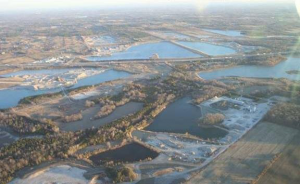REHABILITATION
 The Aggregate Resources Act requires progressive rehabilitation. The ARA states: “Every licensee and every permittee shall perform progressive rehabilitation and final rehabilitation on the site in accordance with this Act, the regulations, the site plan and the conditions of the license or permit to the satisfaction of the Minister” (Section 48). Progressive, comprehensive and integrated rehabilitation would return land to former or appropriate use in keeping with surrounding areas and the community.
The Aggregate Resources Act requires progressive rehabilitation. The ARA states: “Every licensee and every permittee shall perform progressive rehabilitation and final rehabilitation on the site in accordance with this Act, the regulations, the site plan and the conditions of the license or permit to the satisfaction of the Minister” (Section 48). Progressive, comprehensive and integrated rehabilitation would return land to former or appropriate use in keeping with surrounding areas and the community.
“Rehabilitation” is often interpreted by the general public to mean a restoration back to the previous condition, quality and use of the lands. This is rarely, if ever, the case with extraction sites. The Waterloo Federation of Agriculture, in regards to rehabilitating extraction sites back to agricultural use, has stated “It is impossible to rehabilitate farmland back to any semblance of its previous productivity.” By definition, below water table pits and quarries are virtually impossible to convert back to agricultural use, unless water is pumped from the hole in perpetuity. Mounding fertile topsoil in berms for years destroys the microorganisms that are vital to future fertility. Most often, extractive lands, if rehabilitated at all, are turned into open space, lakes / ponds, residential developments, recreational lands, or significantly less productive farmlands.
Over 7,000 abandoned sites remain from before the replacement of the Pits and Quarries Act by the Aggregate Resources Act. A requirement for operators setting a maximum disturbed area as proposed in the current review of the act might hasten progressive rehabilitation and make final, comprehensive rehabilitation more rapid and more common.
Links / References:
“Rehabilitation of Pits and Quarries under Ontario’s Aggregate Resources Act”
State of Aggregate Resources Ontario Study (SAROS) 2009 Report on Rehabilitation: http://files.ontario.ca/environment-and-energy/aggregates/aggregate-resource-in-ontario-study/stdprod_067739.pdf
